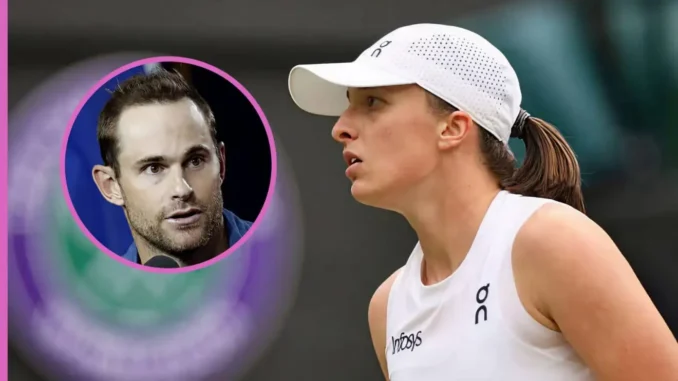
Iga Swiatek, the 23-year-old Polish tennis superstar, is gearing up for her 2025 grass-court campaign at the Bad Homburg Open in Germany, a WTA 500 event that marks her sole tune-up before Wimbledon, starting June 30. Despite her dominance on clay, where she’s claimed four French Open titles, Swiatek’s grass-court record remains a work in progress, with only one Wimbledon quarterfinal in 2023 and no WTA grass finals. As she transitions from her beloved red dirt to the slick, low-bouncing turf, former world No. 1 Andy Roddick, a three-time Wimbledon finalist, has offered pointed tactical advice to help Swiatek unlock her potential on this challenging surface. His insights, shared on the Tennis Channel Live podcast, could be the key to revitalizing her season and silencing critics.
Swiatek’s 2025 has been turbulent. After a stellar 2024, where she won five titles, including her fourth Roland Garros crown, she’s struggled to find her rhythm, failing to reach a WTA final since last June. Her recent clay-court swing, typically her stronghold, saw early exits in Rome and Stuttgart, and a semifinal loss in Madrid. Now ranked No. 8, her lowest position since 2022, Swiatek faces mounting pressure, particularly from Polish media, which Roddick has called out as “moronic” for their relentless scrutiny. “She is the greatest sports person you have ever had,” he declared on his Served with Andy Roddick podcast, urging patience for the five-time Grand Slam champion. As she prepares to face Victoria Azarenka in Bad Homburg’s second round, Swiatek’s grass-court evolution is under the microscope.
Roddick’s advice centers on a tactical overhaul tailored to grass’s unique demands. He urges Swiatek to lean into her backhand, a weapon he believes is underutilized on this surface. “Specifically to Iga on grass, I’d like to see her take more balls in the backhand side and not try to do that little circle to hit the inside-out forehand as much,” Roddick said. Her forehand, with its extreme grip and heavy topspin, generates massive RPMs on clay, pulling opponents off the court. On grass, however, this becomes a “liability,” as the ball sits up, inviting aggressive returns. By contrast, her flatter, penetrating backhand can cut through the court, exploiting grass’s low bounce. “If you’re just left of centre or even if you’re in the middle of the court, the ball on our backhand will be way more effective on the grass getting through the court,” he added.
Roddick also pinpointed Swiatek’s second serve as an area for improvement. Her conservative approach, avoiding wrist pronation, allows opponents to attack. “I think she has to mix up her second serve,” he noted, suggesting she target opponents’ bodies to disrupt their rhythm and force pop-ups rather than clean hits. Coco Vandeweghe, Roddick’s podcast co-host, echoed the need for subtle adjustments, dismissing major changes so close to Wimbledon. “There’s no time to change it now,” Vandeweghe said, but suggested a more closed-stance forehand to stabilize Swiatek’s positioning. These tweaks, Roddick believes, are the “simplest adjustment” to elevate her grass game without overhauling her fierce, spin-heavy style.
Swiatek’s grass struggles are well-documented. Her 2024 Wimbledon campaign ended in a shocking third-round loss to Yulia Putintseva, despite being the top seed. “Grass is the furthest thing from Swiatek’s preferred surface,” a tennis observer noted, citing her 88% win rate on clay compared to a modest 60% on grass. Yet, Roddick remains optimistic, predicting Swiatek will win “nine French Opens and three or four other majors” in her career, including hard-court and grass titles. His faith stems from her Rafael Nadal-like intensity, which he praised after her Australian Open semifinal loss to Madison Keys. “Her intensity point to point is Rafa-like,” he said, noting her ability to reset despite emotional outbursts.
As Swiatek navigates Bad Homburg, seeded fourth behind Jessica Pegula, Jasmine Paolini, and Mirra Andreeva, her match against Azarenka, a former No. 1, is a litmus test. A win could set up a quarterfinal against Ekaterina Alexandrova and a semifinal versus Paolini, offering crucial grass-court reps. Wimbledon’s eighth seed faces a favorable draw, potentially avoiding Aryna Sabalenka and Coco Gauff until the semifinals, but her ability to implement Roddick’s advice will be critical. With a new coach, Wim Fissette, guiding her since November 2024, Swiatek is “searching” for consistency, as Roddick noted, but her Hall of Fame talent remains undeniable. Can she harness her backhand, sharpen her serve, and finally conquer grass? The tennis world awaits her answer on Wimbledon’s hallowed courts.
Leave a Reply